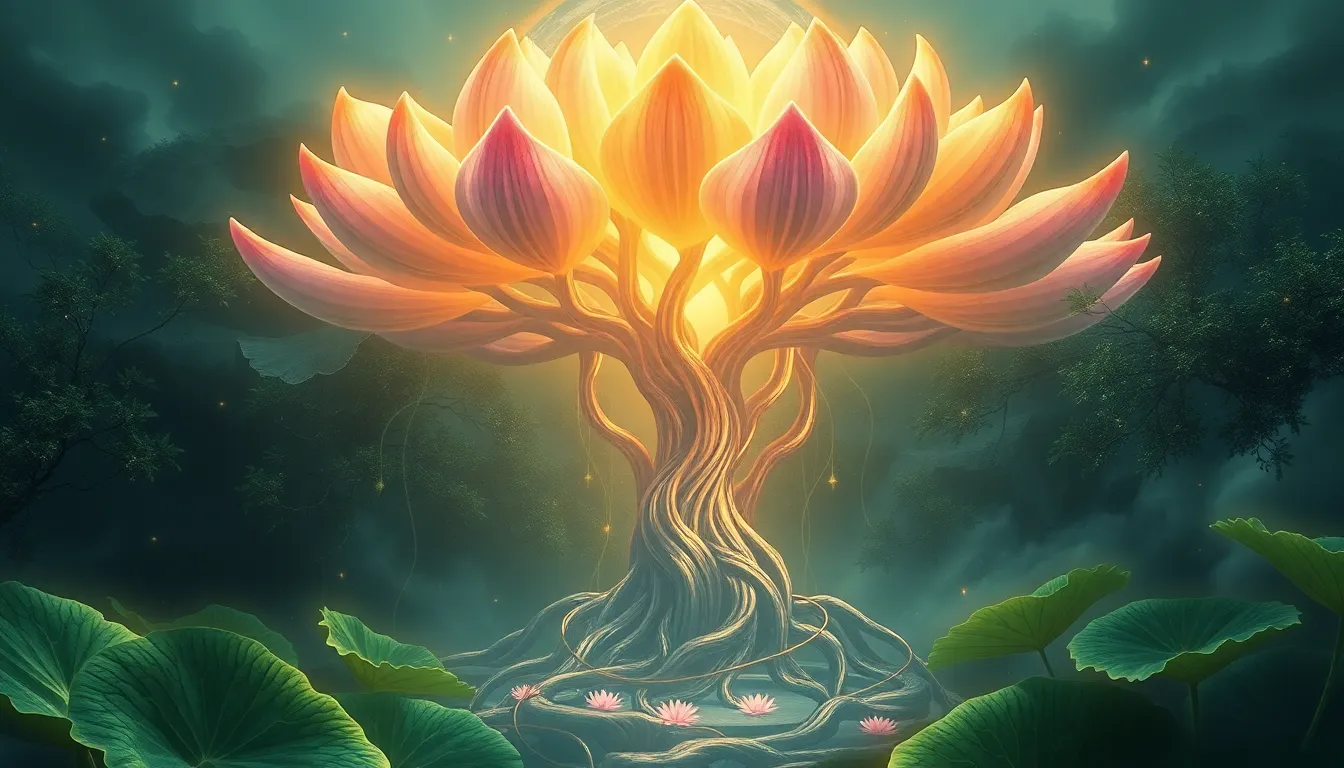The Sacred Lotus Tree: Myths of Enlightenment and Purity
I. Introduction
The Sacred Lotus Tree, often simply referred to as the lotus, holds a profound place in various cultures and spiritual traditions around the world. This remarkable plant is not just admired for its beauty but is also revered as a symbol of enlightenment and purity. The significance of the lotus extends beyond its physical attributes; it embodies deep spiritual meanings that resonate with many seekers of truth and inner peace.
Myths and legends play a crucial role in shaping cultural beliefs and spiritual understandings. They provide frameworks through which individuals can explore complex ideas about existence, morality, and the nature of the divine. Through the lens of the Sacred Lotus Tree, we can delve into these myths to uncover the intertwined themes of enlightenment and purity.
This article aims to explore the multifaceted symbolism of the Sacred Lotus Tree, its place in various cultures, and the lessons it imparts about spiritual growth and purity.
II. The Symbolism of the Lotus in Various Cultures
A. Historical background of the lotus in ancient civilizations
The lotus has been revered since ancient times, with its roots tracing back to civilizations such as the Egyptians, Indians, and Chinese. In ancient Egypt, the blue lotus was associated with the sun god Ra and symbolized creation and rebirth. It was often depicted in art and architecture, showcasing its importance in spiritual practices.
B. The lotus in Eastern religions: Buddhism and Hinduism
In Eastern religions, the lotus takes on significant spiritual meanings:
- Buddhism: The lotus is a central symbol in Buddhism, representing the journey toward enlightenment. It symbolizes the potential for all beings to rise above the murky waters of suffering and ignorance.
- Hinduism: In Hindu mythology, the lotus is associated with several deities, including Lakshmi, the goddess of wealth and purity. It represents divine beauty, fertility, and spiritual awakening.
C. The lotus as a symbol of purity and rebirth in Western traditions
In Western cultures, the lotus has also found its place as a symbol of purity and renewal. The flower’s ability to emerge from muddy waters untainted has inspired various artistic expressions and philosophical interpretations, emphasizing the theme of rebirth and the triumph of the spirit over adversity.
III. Myths and Legends Surrounding the Sacred Lotus Tree
A. Creation myths featuring the lotus
Many cultures have creation myths that feature the lotus. In Hindu cosmology, it is said that the universe was born from a cosmic lotus that emerged from the navel of Vishnu, signifying the birth of all life and the interconnectedness of existence.
B. Folklore: stories of enlightenment associated with the lotus
Folklore around the lotus often tells of individuals who achieve enlightenment after a journey of trials and tribulations, paralleling the lotus’s growth from mud to bloom. These stories serve as metaphors for personal transformation and spiritual awakening.
C. Regional variations in lotus myths across cultures
Across different regions, the myths surrounding the lotus vary, reflecting local beliefs and values. For instance, in some African cultures, the lotus is seen as a symbol of feminine power and fertility, while in Japan, it represents the fleeting nature of life, akin to the cherry blossom.
IV. The Lotus as a Metaphor for Spiritual Growth
A. Stages of lotus growth and their parallels with personal development
The growth of the lotus can be seen as a metaphor for personal development. The stages include:
- Seed: Represents potential and the beginnings of the spiritual journey.
- Bud: Symbolizes the awakening of consciousness and the first steps towards enlightenment.
- Bloom: Denotes the realization of one’s true self and the achievement of spiritual purity.
B. The journey of the lotus from mud to bloom as a path to enlightenment
The journey of the lotus from the muddy depths of a pond to its radiant bloom above the water exemplifies the struggles and challenges faced in the pursuit of enlightenment. This process teaches that beauty and purity can arise from the most challenging circumstances.
C. Lessons learned from the lotus in overcoming adversity
The lotus imparts valuable lessons about resilience and transformation. It reminds us that, despite the difficulties we may face, growth and beauty are possible. Embracing life’s challenges can lead to profound personal development and spiritual awakening.
V. The Sacred Lotus Tree in Art and Literature
A. Depictions of the lotus in ancient texts and religious scriptures
The lotus has been depicted in various ancient texts and scriptures, often symbolizing divine beauty and purity. In the Buddhist texts, the lotus is frequently mentioned as a metaphor for enlightenment and spiritual awakening.
B. Influence of the lotus on art movements and modern interpretations
The lotus has inspired numerous art movements, from traditional Asian painting to modern abstract art. Its representation often conveys themes of peace, tranquility, and spiritual insight.
C. Analysis of poetry and prose that celebrate the lotus as a symbol of purity
Many poets and writers have celebrated the lotus in their works, using it as a symbol of purity and spiritual awakening. The imagery of the lotus often evokes feelings of hope and renewal, resonating deeply with readers seeking inspiration.
VI. The Role of the Lotus in Meditation and Mindfulness Practices
A. The lotus position in yoga and its significance
The lotus position, or Padmasana, is a foundational pose in yoga that symbolizes stability and grounding. It encourages practitioners to find inner peace and balance, embodying the essence of the lotus.
B. Meditation techniques inspired by the lotus and their benefits
Meditation techniques inspired by the lotus often focus on visualizing the flower and its growth process. Benefits of these practices include:
- Enhanced focus and concentration
- Increased emotional stability
- Improved mindfulness and presence
C. The impact of lotus symbolism on mental health and well-being
The symbolism of the lotus can have a positive impact on mental health, serving as a reminder of resilience and the potential for personal growth. Engaging with lotus imagery can foster a sense of peace and encourage individuals to embrace their journeys.
VII. Environmental Significance of the Lotus
A. The ecological role of the lotus in its natural habitat
The lotus plays a vital ecological role in its habitat, providing shelter and food for various aquatic species. Its large leaves help reduce water evaporation and improve water quality by filtering pollutants.
B. Conservation efforts for lotus species and their importance to biodiversity
Many lotus species face threats due to habitat loss and climate change. Conservation efforts focus on protecting these plants to maintain biodiversity and the health of aquatic ecosystems.
C. The connection between environmental purity and spiritual enlightenment
The lotus symbolizes the connection between environmental purity and spiritual enlightenment. Just as the lotus rises untainted from muddy waters, humanity must strive for purity in both nature and spirit.
VIII. Contemporary Interpretations of the Sacred Lotus Tree
A. Modern spiritual practices that incorporate the lotus motif
In contemporary spiritual practices, the lotus motif is often incorporated into rituals, art, and personal development frameworks. It serves as a powerful reminder of transformation and the journey toward inner peace.
B. The lotus in popular culture: film, music, and fashion
The lotus has permeated popular culture, appearing in films, music, and fashion as a symbol of beauty, purity, and enlightenment. Its imagery is used to convey themes of renewal and hope.
C. Global movements promoting the lotus as a symbol of peace and unity
Various global movements have embraced the lotus as a symbol of peace and unity, promoting messages of understanding and compassion across cultures. This reflects the universal appeal of the lotus as a symbol of spiritual growth.
IX. Critiques and Misinterpretations of Lotus Symbolism
A. Cultural appropriation and the commercialization of lotus imagery
As the lotus has gained popularity in modern culture, issues of cultural appropriation and commercialization have arisen. It is essential to approach the lotus’s symbolism with respect for its cultural roots and meanings.



